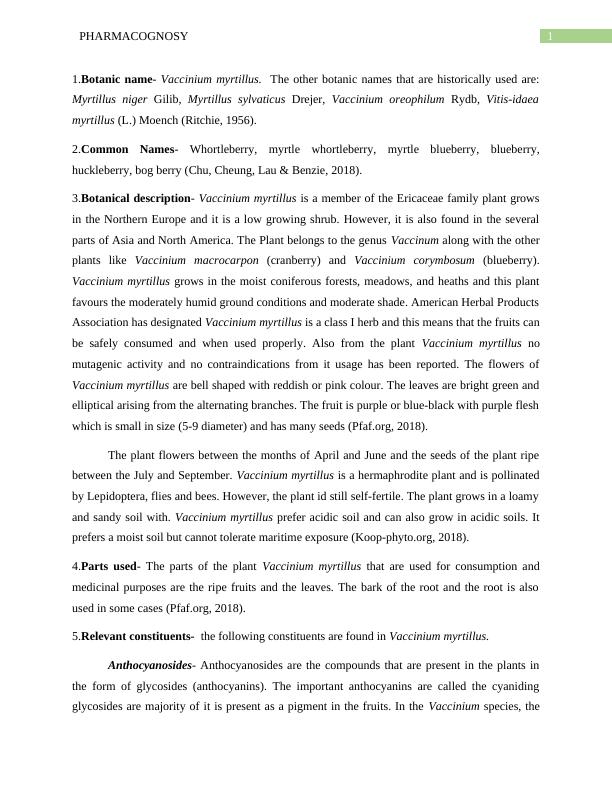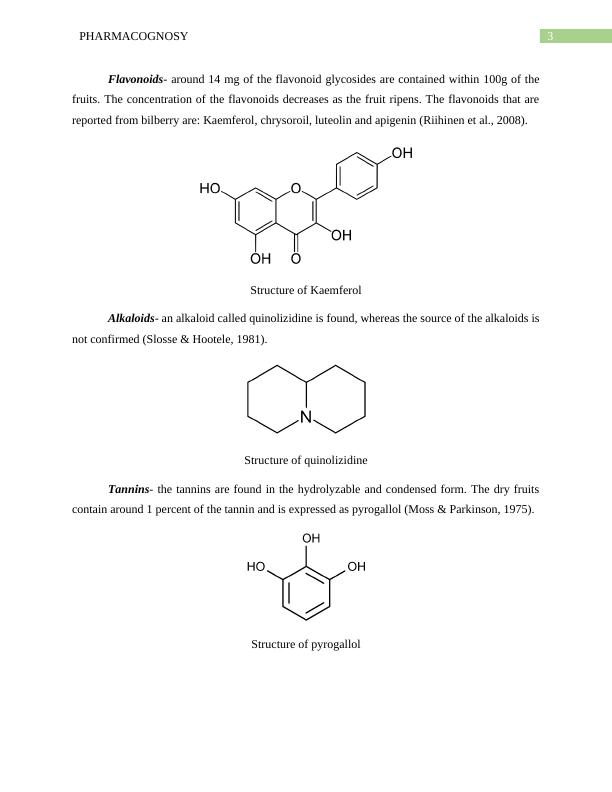Pharmacognosy and Herbal Monograph
Added on 2023-06-08
12 Pages3186 Words432 Views
Running head: PHARMACOGNOSY
Pharmacognosy and Herbal Monograph
Name of the Student:
Name of the University:
Author Note:
Pharmacognosy and Herbal Monograph
Name of the Student:
Name of the University:
Author Note:

1PHARMACOGNOSY
1.Botanic name- Vaccinium myrtillus. The other botanic names that are historically used are:
Myrtillus niger Gilib, Myrtillus sylvaticus Drejer, Vaccinium oreophilum Rydb, Vitis-idaea
myrtillus (L.) Moench (Ritchie, 1956).
2.Common Names- Whortleberry, myrtle whortleberry, myrtle blueberry, blueberry,
huckleberry, bog berry (Chu, Cheung, Lau & Benzie, 2018).
3.Botanical description- Vaccinium myrtillus is a member of the Ericaceae family plant grows
in the Northern Europe and it is a low growing shrub. However, it is also found in the several
parts of Asia and North America. The Plant belongs to the genus Vaccinum along with the other
plants like Vaccinium macrocarpon (cranberry) and Vaccinium corymbosum (blueberry).
Vaccinium myrtillus grows in the moist coniferous forests, meadows, and heaths and this plant
favours the moderately humid ground conditions and moderate shade. American Herbal Products
Association has designated Vaccinium myrtillus is a class I herb and this means that the fruits can
be safely consumed and when used properly. Also from the plant Vaccinium myrtillus no
mutagenic activity and no contraindications from it usage has been reported. The flowers of
Vaccinium myrtillus are bell shaped with reddish or pink colour. The leaves are bright green and
elliptical arising from the alternating branches. The fruit is purple or blue-black with purple flesh
which is small in size (5-9 diameter) and has many seeds (Pfaf.org, 2018).
The plant flowers between the months of April and June and the seeds of the plant ripe
between the July and September. Vaccinium myrtillus is a hermaphrodite plant and is pollinated
by Lepidoptera, flies and bees. However, the plant id still self-fertile. The plant grows in a loamy
and sandy soil with. Vaccinium myrtillus prefer acidic soil and can also grow in acidic soils. It
prefers a moist soil but cannot tolerate maritime exposure (Koop-phyto.org, 2018).
4.Parts used- The parts of the plant Vaccinium myrtillus that are used for consumption and
medicinal purposes are the ripe fruits and the leaves. The bark of the root and the root is also
used in some cases (Pfaf.org, 2018).
5.Relevant constituents- the following constituents are found in Vaccinium myrtillus.
Anthocyanosides- Anthocyanosides are the compounds that are present in the plants in
the form of glycosides (anthocyanins). The important anthocyanins are called the cyaniding
glycosides are majority of it is present as a pigment in the fruits. In the Vaccinium species, the
1.Botanic name- Vaccinium myrtillus. The other botanic names that are historically used are:
Myrtillus niger Gilib, Myrtillus sylvaticus Drejer, Vaccinium oreophilum Rydb, Vitis-idaea
myrtillus (L.) Moench (Ritchie, 1956).
2.Common Names- Whortleberry, myrtle whortleberry, myrtle blueberry, blueberry,
huckleberry, bog berry (Chu, Cheung, Lau & Benzie, 2018).
3.Botanical description- Vaccinium myrtillus is a member of the Ericaceae family plant grows
in the Northern Europe and it is a low growing shrub. However, it is also found in the several
parts of Asia and North America. The Plant belongs to the genus Vaccinum along with the other
plants like Vaccinium macrocarpon (cranberry) and Vaccinium corymbosum (blueberry).
Vaccinium myrtillus grows in the moist coniferous forests, meadows, and heaths and this plant
favours the moderately humid ground conditions and moderate shade. American Herbal Products
Association has designated Vaccinium myrtillus is a class I herb and this means that the fruits can
be safely consumed and when used properly. Also from the plant Vaccinium myrtillus no
mutagenic activity and no contraindications from it usage has been reported. The flowers of
Vaccinium myrtillus are bell shaped with reddish or pink colour. The leaves are bright green and
elliptical arising from the alternating branches. The fruit is purple or blue-black with purple flesh
which is small in size (5-9 diameter) and has many seeds (Pfaf.org, 2018).
The plant flowers between the months of April and June and the seeds of the plant ripe
between the July and September. Vaccinium myrtillus is a hermaphrodite plant and is pollinated
by Lepidoptera, flies and bees. However, the plant id still self-fertile. The plant grows in a loamy
and sandy soil with. Vaccinium myrtillus prefer acidic soil and can also grow in acidic soils. It
prefers a moist soil but cannot tolerate maritime exposure (Koop-phyto.org, 2018).
4.Parts used- The parts of the plant Vaccinium myrtillus that are used for consumption and
medicinal purposes are the ripe fruits and the leaves. The bark of the root and the root is also
used in some cases (Pfaf.org, 2018).
5.Relevant constituents- the following constituents are found in Vaccinium myrtillus.
Anthocyanosides- Anthocyanosides are the compounds that are present in the plants in
the form of glycosides (anthocyanins). The important anthocyanins are called the cyaniding
glycosides are majority of it is present as a pigment in the fruits. In the Vaccinium species, the

2PHARMACOGNOSY
anthocyanins are present in the ripe fruits but a majority of the anthocyanins are present in
Vaccinium myrtillus fruits. The total anthocyanin content of a ripe fruit is about 300 to 700
grams in Vaccinium myrtillus. Also, it is important to note that the content of the anthocyanins
varies depending on the geographical area and this varies from the 19 to 38 mg/g of dry weight
fruit. In the concentrated extracts of the bilberry extracts, the total content of anthocyanin is
almost about 24 percent. An estimation was made by the European Pharmacopoeia 8.0 which
says that a dry extract of Vaccinium myrtillus consists of 32 percent to 39 percent of anthocyanin
and it is expressed in the form of cyanide 3-O-glucoside chloride (European Pharmacopoeia,
2018). Studies have shown that Vaccinium myrtillus contains about 14 to 15 anthocyanins. 15
different anthocyanins are found to be in bilberry extract, juice and fruit (Canter & Ernst, 2004).
Structure of cyanide 3-O-glucoside chloride
Polyphenols- the major polyphenols that are found within the bilberry are the
Proanthocyanidins and Flavan-3-ols. The amount of the polyphenols is inversely related with the
ripening of the fruit. The other identified polyphenols are the cathechin-dimer B-3, Epicatechin-
dimer B-2 (Faria et al., 2005).
Structure of Proanthocyanidins
anthocyanins are present in the ripe fruits but a majority of the anthocyanins are present in
Vaccinium myrtillus fruits. The total anthocyanin content of a ripe fruit is about 300 to 700
grams in Vaccinium myrtillus. Also, it is important to note that the content of the anthocyanins
varies depending on the geographical area and this varies from the 19 to 38 mg/g of dry weight
fruit. In the concentrated extracts of the bilberry extracts, the total content of anthocyanin is
almost about 24 percent. An estimation was made by the European Pharmacopoeia 8.0 which
says that a dry extract of Vaccinium myrtillus consists of 32 percent to 39 percent of anthocyanin
and it is expressed in the form of cyanide 3-O-glucoside chloride (European Pharmacopoeia,
2018). Studies have shown that Vaccinium myrtillus contains about 14 to 15 anthocyanins. 15
different anthocyanins are found to be in bilberry extract, juice and fruit (Canter & Ernst, 2004).
Structure of cyanide 3-O-glucoside chloride
Polyphenols- the major polyphenols that are found within the bilberry are the
Proanthocyanidins and Flavan-3-ols. The amount of the polyphenols is inversely related with the
ripening of the fruit. The other identified polyphenols are the cathechin-dimer B-3, Epicatechin-
dimer B-2 (Faria et al., 2005).
Structure of Proanthocyanidins

3PHARMACOGNOSY
Flavonoids- around 14 mg of the flavonoid glycosides are contained within 100g of the
fruits. The concentration of the flavonoids decreases as the fruit ripens. The flavonoids that are
reported from bilberry are: Kaemferol, chrysoroil, luteolin and apigenin (Riihinen et al., 2008).
Structure of Kaemferol
Alkaloids- an alkaloid called quinolizidine is found, whereas the source of the alkaloids is
not confirmed (Slosse & Hootele, 1981).
Structure of quinolizidine
Tannins- the tannins are found in the hydrolyzable and condensed form. The dry fruits
contain around 1 percent of the tannin and is expressed as pyrogallol (Moss & Parkinson, 1975).
Structure of pyrogallol
Flavonoids- around 14 mg of the flavonoid glycosides are contained within 100g of the
fruits. The concentration of the flavonoids decreases as the fruit ripens. The flavonoids that are
reported from bilberry are: Kaemferol, chrysoroil, luteolin and apigenin (Riihinen et al., 2008).
Structure of Kaemferol
Alkaloids- an alkaloid called quinolizidine is found, whereas the source of the alkaloids is
not confirmed (Slosse & Hootele, 1981).
Structure of quinolizidine
Tannins- the tannins are found in the hydrolyzable and condensed form. The dry fruits
contain around 1 percent of the tannin and is expressed as pyrogallol (Moss & Parkinson, 1975).
Structure of pyrogallol

End of preview
Want to access all the pages? Upload your documents or become a member.
